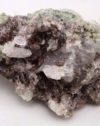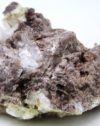HISTORY, NAME, LOCALITIES: Dioptase, pronounced dye-OPP-taze, was discovered in the late 1700s by copper miners in Kazakhstan who thought they had found the emerald variety of beryl. Dioptase was identified as a new mineral in 1797. Its name is derived from the Greek words dia, meaning “through,” and optima, meaning “vision,” alluding to its cleavage planes that are visible in transparent crystals. Dioptase is collected in Chile, Mexico, Australia, New Zealand, Democratic Republic of Congo, Russia, Italy, and the United States (California, Pennsylvania).
MINERALOGY, PROPERTIES, OCCURRENCE: Dioptase [hydrous copper silicate, Cu6Si6O18•6H2O] crystallizes in the trigonal system as short, six-sided prisms capped by rhombohedral terminations. It also occurs in granular and massive forms. Dioptase has a Mohs hardness of 5.0, perfect cleavage in three directions, conchoidal-to-uneven fracture, vitreous luster, and a specific gravity of 3.3-3.4. It is transparent to translucent and has a distinctive, bright, emerald-green color. Dioptase is a secondary mineral that forms in the shallow oxidation zones of copper deposits, usually in arid climates. It is one of the few copper-silicate minerals.
METAPHYSICAL PROPERTIES, LORE, USES: Metaphysical practitioners believe that dioptase helps heal emotional distress, awakens love and compassion, and stimulates the ability to forgive. Dioptase is sometimes cut into attractive, emerald-like gems. Apart from having occasionally served as a minor ore of copper, dioptase has no technological uses.
COLLECTORS’ INFORMATION: Dioptase is widely collected for its excellent crystal development and bright, emerald-green color.





 Axinite #10
Axinite #10  Axinite #8
Axinite #8